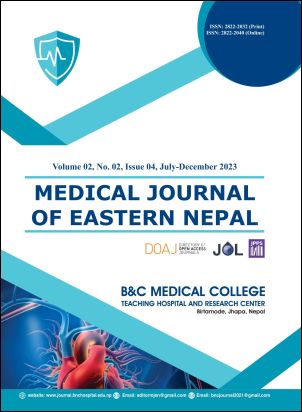Microbiological Spectrum Causing Chronic Suppurative Otitis Media and Determination of the Antibiotic Sensitivity Pattern of Isolated Bacteria
DOI:
https://doi.org/10.3126/mjen.v2i02.60782Keywords:
Antibiotic sensitivity, Chronic suppurative otitis media (CSOM), Ear discharge, Staphylococcus aureusAbstract
Background: The middle ear cleft is chronically inflamed in chronic suppurative otitis media (CSOM). It is one of the most prevalent hearing issues and, if unchecked, can lead to a number of difficulties. The most common bacteria causing CSOM are Staphylococcus aureus, Pseudomonas aeruginosa and Escherichia coli. This study was conducted to identify the typical bacteria and fungi that cause CSOM and to assess the susceptibility of bacterial isolates to various antibiotics.
Methods: From 119 patients, 125 ear pus samples from the ENT outpatient department of Devdaha Medical College were determined to be culture positive. The patients gave their written consent. There were two swabs taken from the discharged ear. Gram staining was done on the first swab, and culture and sensitivity were done on the second. Simple statistical techniques were used for the analysis of the results.
Results: Patients between the ages of 11 and 30 were frequently affected, with the left ear predominating. Staphylococcus aureus and Pseudomonas aeruginosa were the most frequently isolated microorganisms, followed by Escherichia coli, Klebsiella pneumoniae, and Proteus mirabilis. Most of the bacteria were highly sensitive to, Amikacin, Vancomycin, Piperacillin/Tazobactam and developing resistance to Amoxicillin/Clavulanic acid, Ciprofloxacin and Tetracycline.
Conclusion: The most frequent bacteria found were Staphylococcus aureus, which was also the most responsive to Amikacin (96.22%) and Ciprofloxacin (26.41%). In the view of developing antibiotic resistance, and extra- and intracranial complications in improperly treated cases, judicial use of antibiotics is necessary.
Downloads
Downloads
Published
How to Cite
Issue
Section
License
Copyright (c) 2023 B & C Medical College and Teaching Hospital and Research Centre

This work is licensed under a Creative Commons Attribution 4.0 International License.
CC BY: This license allows reusers to distribute, remix, adapt, and build upon the material in any medium or format, so long as attribution is given to the creator. The license allows for commercial use.




